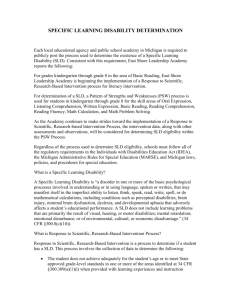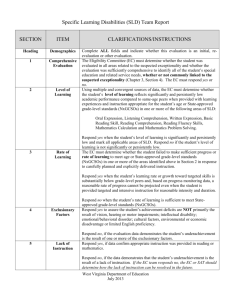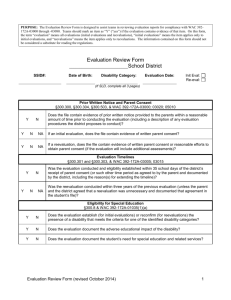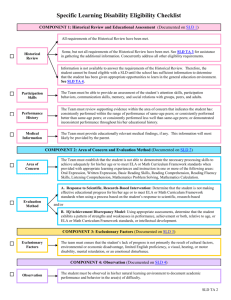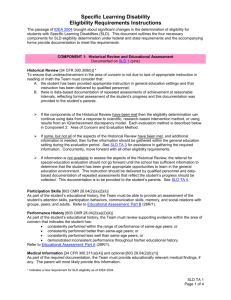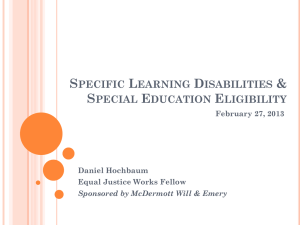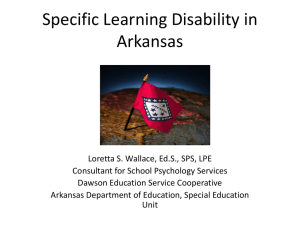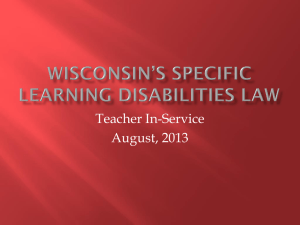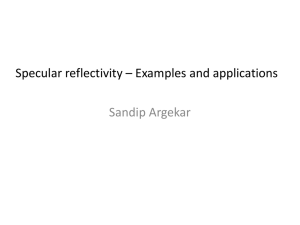IDofSLD MEGA 2014-compressed FINAL4CW SES
advertisement
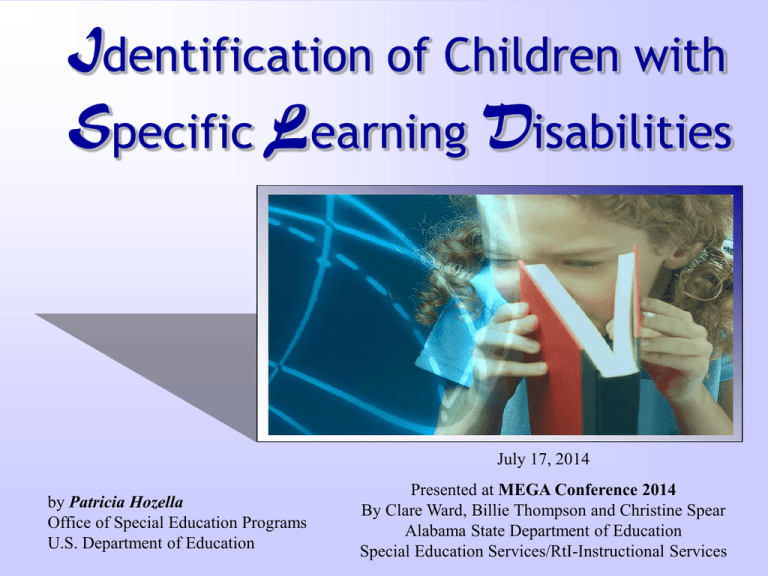
Identification of Children with Specific Learning Disabilities July 17, 2014 by Patricia Hozella Office of Special Education Programs U.S. Department of Education Presented at MEGA Conference 2014 By Clare Ward, Billie Thompson and Christine Spear Alabama State Department of Education Special Education Services/RtI-Instructional Services Disadvantages of Discrepancy Model Clinicians using the same discrepancy formula, but different tests, may arrive at different classifications. Using discrepancy formulas without regard for the absolute level of the child’s performance may result in serious misinterpretations and misclassifications. Jerome M. Sattler, Oct.2012 Disadvantages of Discrepancy Model Discrepancy formulas are based on the assumption that the tests used to evaluate a child’s intelligence and achievement measure independent constructs, when in fact achievement and intelligence tests measure similar constructs (e.g., vocabulary, mathematics, factual information). Jerome M. Sattler, Oct.2012 Disadvantages of Discrepancy Model Discrepancy formulas fail to identify children with learning disabilities who show no discrepancy between achievement and intelligence test scores. Discrepancy formulas have never been empirically validated. The discrepancy formula approach prevents children from receiving services during their early school years. Jerome M. Sattler, Oct.2012 Reason for Change • • • • • Current system – process above results. Current system – wait to fail. Culture of compliance; focus on compliance and bureaucratic imperatives not academic achievement. Identification methods lack validity. “…the IQ-achievement discrepancy does not reliability distinguish between disabled and nondisabled readers…children who were found to be difficult [and easy] to remediate…and it does not predict response to remediation.” Velutino et al., 2000) Jerome M. Sattler, Oct.2012 Federal SLD Criteria Made Easy Putting It Together Overview Three s Needed to Determine SLD §300.309(a)(2) §300.309(a)(1) §300.309(a)(3) Exclusionary Factors Underachievement for age or on State approved grade-level standards and (i) RtI or (ii) PSW 1 & 2 are not primarily the result of visual, hearing, or motor disability, intellectual disability, emotional disability, cultural factors, environmental, economic disadvantage or Limited English proficiency and Referral Form page 3: ENVIRONMENTAL, CULTURAL, AND/OR ECONOMIC CONCERNS Use this checklist: 1. To determine factors impacting a student’s learning and therefore excluding him/her from being identified as a student with a disability. 2. To determine whether or not a student needs to be administered a non-traditional intelligence test if there is environmental, language, cultural, and/or economic concerns checked. 3. To consider if there has been a lack of appropriate instruction in reading and/or math. Referral Form, page 4 - FOR IEP TEAM USE ONLY The answer to each question listed should be YES if the IEP Team decides to accept the referral for further evaluation. 1. Does the data support that the reason for referral has a direct impact on the student’s educational performance, or for a preschool child, participation in age appropriate activities? [ ] Yes [ ] No 2. Does the data support the severity of the reason for referral? [ ]Yes [ ]No 3. Does the data support the duration of the reason for referral? [ ]Yes [ ]No 4. Does the data support the valid implementation of intervention(s) for the referral concern(s) (e.g., appropriate target behavior, relationship of intervention to target behavior, duration of intervention, integrity of implementation, data collection procedures)? [ ]Yes [ ]No [ ]NA Referral Form, page 4 - FOR IEP TEAM USE ONLY 5. Does the data support the ineffectiveness of the intervention(s) for the referral concern(s)? [ ]Yes [ ]No [ ]NA 6. Does the data include multiple sources of information about the reason for referral? [ ]Yes [ ] No ******** Questions 5. and 6. apply only to those referrals that require intervention strategies. Check NA if intervention strategies were waived. Definition of Specific Learning Disability Learning disability or specific learning disability? Defined at §300.8(c)(10) as… A disorder in one or more of the basic psychological processes involved in understanding or in using language, spoken or written… Definition of Specific Learning Disability …May manifest itself in the imperfect ability to: • • • • • • • listen think speak read write spell do mathematical calculations… Definition of Specific Learning Disability …including conditions such as: • perceptual disabilities • brain injury • minimal brain dysfunction • dyslexia • developmental aphasia Definition of Specific Learning Disability Does not include learning problems that are primarily the result of: • visual, hearing, or motor disabilities • mental retardation • emotional disturbance • of environmental, cultural, or economic disadvantage Determining SLD IDEA includes additional procedures for determining SLD. §300.307 Where shall we begin? A Close Look at §300.307 State must adopt criteria* for determining whether a child has an SLD as defined in IDEA Public agencies must use State criteria in determining whether a child has an SLD * Consistent with §300.309 of Part B A Close Look at §300.307 State criteria may not require use of severe discrepancy between intellectual ability and achievement for determining whether a child has an SLD. A Close Look at §300.307 State criteria must permit use of a process based on the child's response to scientific, research-based intervention. A Close Look at §300.307 State criteria may permit use of other alternative research-based procedures. Group Determining SLD Determination of SLD is made by child’s parents and a team of qualified professionals, which must include: Child’s regular teacher If child does not have a regular teacher: A regular classroom teacher qualified to teach a child of his or her age If child is less than school age: An individual qualified by SEA to teach a child of his or her age Group Determining SLD At least one person qualified to conduct individual diagnostic examinations of children… Such as… school psychologist speech-language pathologist remedial reading teacher Determining SLD Factors involved: Child’s achievement levels in 1 (or more) of 8 specified areas: Oral expression Listening comprehension Written expression Basic reading skill Reading fluency skills Reading comprehension Math calculation Math problem solving and… Determining SLD Child’s progress in 1 (or more) of these 8 areas is not sufficient to meet age or State-approved grade level standards when his or her response to scientific, researchbased intervention is part of determination process Child exhibits a pattern of strengths and weaknesses in performance, achievement, or both: age Relative to: State-approved grade level standards, or intellectual development …that group determines is relevant and… to identification of SLD Determining SLD Group determines that its findings are not primarily the result of: Visual, hearing, or motor disability Mental retardation Emotional disturbance Cultural factors Environmental or economic disadvantage Limited English proficiency “Either / Or / And”— Putting It Together Three s Needed to Determine SLD §300.309(a)(2) §300.309(a)(1) §300.309(a)(3) Exclusionary Factors Underachievement for age or on State approved grade-level standards and (i) RtI or (ii) PSW (1 & 2 are not primarily the result of visual, hearing, or motor disability, intellectual disability, emotional disability, cultural factors, environmental, economic disadvantage or Limited English proficiency and Determining SLD Purpose: To ensure child’s underachievement is not due to lack of appropriate instruction in reading or math Group must consider data in 2 areas: Data showing that child was provided appropriate instruction in regular education settings, delivered by qualified personnel, before (or as part of) referral process and… Determining SLD Data-based documentation that child’s achievement was repeatedly assessed at reasonable intervals This documentation: Reflects formal assessment of student progress during instruction Was provided to the child's parents Determining SLD Public agency must promptly request parent consent for evaluation: Whenever child is referred for evaluation If, before referral for evaluation, child has not made adequate progress… after appropriate period of time when provided appropriate instruction by qualified personnel Observation in SLD Determination Public agency must ensure: Child is observed in his or her learning environment (including the regular classroom setting) to document child's academic performance and behavior in the areas of difficulty Observation in SLD Determination Group must decide whether to: Use information from observation done before child was referred for an evaluation routine classroom instruction monitoring of child's performance Have at least one group member conduct observation after child has been referred for evaluation and parental child’s academic consent performance in regular classroom Observation in SLD Determination Observation of child less than school age or out of school: Group member must observe child in environment appropriate for a child of that age Documenting the Determination of Eligibility For a child suspected of having SLD, documentation of determination of eligibility must contain a statement of 7 elements: 1. Whether child has a specific learning disability 2. Basis for making the determination* and… * …including assurance that qualified professionals and child’s parent determined child was a “child with a disability” and his or her educational needs Documenting the Determination of Eligibility 3. Relevant behavior (if any) noted during observation of child and relationship of that behavior to child's academic functioning 4. Educationally relevant medical findings (if any) and… Documenting the Determination of Eligibility 5. Whether child does not achieve adequately: for the child's age, or to meet State-approved grade-level standards* and… * Consistent with §300.309(a)(1) Documenting the Determination of Eligibility 5. Continued… Child does not make sufficient progress to meet age or State grade-level standards ** Child exhibits pattern of strengths and weaknesses in performance, achievement, or both, relative to age, State grade-level standards or intellectual development *** ** *** Consistent with §300.309(a)(2)(i) Consistent with §300 .309(a)(2)(ii) and… Documenting the Determination of Eligibility 6. What the group has determined concerning effects on the child's achievement level of— Visual, hearing, or motor Mental retardation disability Emotional disturbance Cultural factors Environmental or economic Limited English disadvantage proficiency and… Documenting the Determination of Eligibility 7. If child has participated in a process assessing his or her response to scientific, research-based intervention— instructional strategies used and student-centered data collected; and documentation that child's parents were notified about 3 things, as follows… Documenting the Determination of Eligibility …that child's parents were notified about— State's policies regarding amount and nature of student performance data that would be collected and general education services that would be provided Strategies for increasing the child's rate of learning Parents' right to request an evaluation Documenting the Determination of Eligibility Each member of group must certify in writing whether report reflects the member's conclusion If report does not: Member must submit a separate statement presenting his or her conclusions Questions for ALSDE/SES? Clare Ward - cward@alsde Billie Thompson - billiet@alsde.edu 334-224-8114 and Christine Spear – cspear@alsde.edu 334-353-1191 President’s Message “I would hope that the goal here is to expand the methods of assessment available to the practitioner and not to limit them. It seems possible that these two very valuable approaches can be utilized along a continuum of collecting information about a child that would culminate in a very clear and comprehensive evaluation that would be of value to all.” Huff, L. (2005, February). President’s Message. NASP Communique, 33, 2-3. 42
